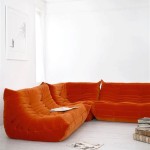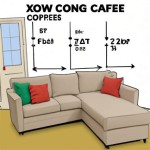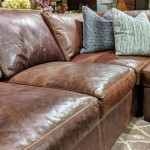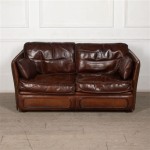The Enduring Charm of the Two-Seater Retro Sofa
The two-seater retro sofa occupies a unique niche in the furniture market. It represents more than just a seating arrangement; it embodies an aesthetic sensibility rooted in design movements of the mid-20th century, often characterized by clean lines, bold colors, and a focus on functionality. These sofas offer a blend of comfort, style, and a nostalgic appeal that resonates with a broad audience, from those seeking to recreate a specific vintage vibe to those who appreciate the enduring elegance of classic design.
Retro furniture, in general, has experienced a resurgence in popularity in recent years. This trend can be attributed to several factors. Firstly, there is a growing appreciation for the quality and craftsmanship often found in vintage pieces. Unlike mass-produced, disposable furniture, retro sofas were often built to last, using durable materials and employing skilled construction techniques. Secondly, the unique character and visual interest of retro designs provide a refreshing contrast to the often-sterile and minimalist aesthetic of contemporary interiors. Finally, the sustainability aspect of repurposing and restoring vintage furniture aligns with a growing awareness of environmental responsibility.
The two-seater retro sofa, specifically, offers several advantages over larger seating options. Its compact size makes it ideal for smaller living spaces, apartments, and even home offices. It allows for flexibility in room arrangements and can be easily moved and re-positioned as needed. Furthermore, the intimate seating arrangement it provides fosters a sense of connection and conversation, making it perfect for couples or small families.
Key Elements of Retro Sofa Design
Identifying a true retro sofa requires an understanding of the design characteristics that define the era. Several key elements distinguish retro sofas from their modern counterparts.
Firstly, the silhouette is often a defining feature. Retro sofas typically feature clean, geometric lines, with low-profile designs and a focus on horizontal planes. This contrasts with the often-plush and voluminous shapes of more contemporary sofas. Common shapes include rectangular forms with rounded edges, boomerang shapes, and even more angular, atomic-inspired designs. The emphasis is on simplicity and visual balance.
Secondly, the upholstery plays a crucial role in defining the retro aesthetic. Common upholstery materials include textured fabrics such as tweed, boucle, and vinyl. Leather, particularly in shades of tan, brown, and black, is also a popular choice. Color palettes tend to be bold and vibrant, reflecting the optimistic spirit of the mid-century era. Popular colors include avocado green, mustard yellow, burnt orange, and turquoise. Geometric patterns, such as chevron, stripes, and abstract shapes, are also frequently employed.
Thirdly, the legs of the sofa are often a distinctive design element. Tapered wooden legs, often made from hardwoods like teak or walnut, are a hallmark of retro sofas. These legs are typically angled outwards, providing both structural support and a visual flair. Metal legs, often chrome or brass-plated, are also common, particularly in more modern interpretations of the retro style. The legs are often slender and understated, allowing the focus to remain on the sofa's overall form and upholstery.
Materials and Construction in Vintage Sofas
The quality and durability of a retro sofa are largely determined by the materials and construction techniques used in its creation. Understanding these aspects is essential for discerning genuine vintage pieces from reproductions.
The frame of a retro sofa is typically constructed from solid hardwood, such as oak, maple, or birch. Hardwood provides a strong and stable foundation that can withstand years of use. The joints are often reinforced with screws, dowels, and glue, ensuring long-lasting structural integrity. The frame should be solid and free from cracks or warping.
The suspension system of the sofa provides support and comfort. Common suspension systems in retro sofas include coil springs, webbing, and sinuous springs. Coil springs offer excellent support and durability, while webbing provides a more flexible and comfortable seating experience. Sinuous springs, also known as no-sag springs, are a more modern option that offers a balance of support and comfort. The suspension system should be firm and supportive, without any sagging or excessive movement.
The cushioning of the sofa is typically composed of foam, feathers, or a combination of both. High-density foam provides excellent support and retains its shape over time. Feather cushions offer a luxurious and comfortable seating experience but require more frequent fluffing and maintenance. The cushioning should be comfortable and supportive, without any lumps or unevenness. The upholstery fabric should be durable and stain-resistant, capable of withstanding daily wear and tear.
Incorporating a Two-Seater Retro Sofa into Modern Interiors
Integrating a two-seater retro sofa into a modern interior requires careful consideration of the room's overall design and aesthetic. When done well, a retro sofa can add a touch of character and personality to a space, creating a stylish and inviting atmosphere.
One approach is to use the sofa as a focal point in the room. This can be achieved by selecting a sofa with a bold color or pattern that contrasts with the surrounding décor. The sofa can then be paired with complementary accessories, such as throw pillows, rugs, and artwork, to create a cohesive and harmonious look. The key is to balance the retro aesthetic with modern elements to avoid creating a space that feels dated or overly nostalgic.
Another approach is to incorporate the sofa into a more eclectic or bohemian-inspired interior. This involves mixing and matching different styles and eras to create a unique and personalized space. A retro sofa can be paired with vintage furniture, contemporary artwork, and ethnic textiles to create a layered and visually interesting look. The key is to maintain a sense of balance and harmony, ensuring that the different elements work together to create a cohesive whole.
Consider the color palette of the room when selecting a retro sofa. If the room has a neutral color scheme, a brightly colored sofa can add a pop of visual interest. Conversely, if the room is already filled with color, a more neutral-toned sofa can provide a calming and grounding element. The upholstery fabric should also be considered in relation to the other textiles in the room. A textured fabric, such as tweed or boucle, can add depth and dimension to the space. A smooth fabric, such as leather or vinyl, can create a more sleek and modern look.
Finally, pay attention to the scale and proportion of the sofa in relation to the other furniture in the room. A two-seater sofa is typically smaller than a larger sectional or sofa, so it's important to ensure that it doesn't get lost in the space. Use rugs, coffee tables, and other accessories to define the seating area and create a sense of balance. The placement of the sofa is also important. Consider placing it against a wall or in front of a window to create a natural focal point. The goal is to create a comfortable and inviting seating area that is both stylish and functional.

Newport Leather Retro Two Seat Apartment Sofa

Danish Vintage Model 55 Velvet Mid Century 50s 2 Seat Lounge Sofa Settee Saffron

Loveseat Sofa Vintage 55 9 Upholstered Two Seater With 2 Dumpling Shaped Throw Pillows Arm Rest And Solid Wood Legs Tulip Pattern Mid Century

Hkliving Retro Sofa 2 Seater Velvet Ocher

2 Seater Vintage Tan Leather Chesterfield Sofa Light Grey Wool British Handmade

Wonder Comfort Simple Retro 74 In Black Comfy Corduroy Fabric Rectangle 2 Seater Loveseat With Solid Wood Pillows Tn Sf2s40 Bk

Retro Sofa

Moby Two Seater Retro Sofa At Made

Wonder Comfort Simple Retro 74 In Orange Comfy Corduroy Fabric Rectangle 2 Seater Loveseat With Solid Wood Pillows Tn Sf2s40 Or The Home Depot

Hepburn Vintage Velvet 2 Seat Sofa From Old Boot Sofas








